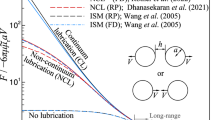Abstract
Interphase momentum exchange of a polydispersed two-phase flow is numerically studied by using a model based on interfacial drag effects of a bulk liquid, ligaments, and droplets entrained in the air flow. A power-law relation is proposed between the droplet velocity and its diameter. The dispersed phase is modeled using the methodology of spray moments of the drop size distribution. All the equations are solved in a Eulerian framework using the finite volume approach, and the phases are coupled with the source terms. The proposed dependence accurately simulates the droplet behavior because droplets with larger diameters experience a higher drag and generally have higher velocities than smaller droplets. The model shows reasonable agreement with experimental and numerical data on the spray tip penetration and Sauter mean radius.
Similar content being viewed by others
References
J. Beck and A. Watkins, “On the Development of a Spray Model Based on Drop-Size Moments,” Proc. Roy. Soc. London, Ser. A: Math. Phys. Eng. Sci. 459, 1365–1394 (2003).
P. Moin and S. V. Apte, “Large-Eddy Simulation of Realistic Gas Turbine Combustors,” AIAA J. 44 (4), 698–708 (2006).
B. Mohan, W. Yang, K. L. Tay, and W. Yu, “Macroscopic Spray Characterization under High Ambient Density Conditions,” Exp. Therm. Fluid Sci. 59, 109–117 (2014).
V. K. Champagne, D. J. Helfritch, S. P. G. Dinavahi, and P. F. Leyman, “Theoretical and Experimental Particle Velocity in Cold Spray,” J. Therm. Spray Technol. 20 (3), 425–431 (2011).
M. Karimi, A. Fartai, G. Rankin, et al., “Numerical Simulation of the Cold Gas Dynamic Spray Process,” J. Therm. Spray Technol. 15 (4), 518–523 (2006).
H. Katanoda, M. Fukuhara, and N. Iino, “Numerical Study of Combination Parameters for Particle Impact Velocity and Temperature in Cold Spray,” J. Therm. Spray Technol. 16 (5/6), 627–633 (2007).
B. Samareh, O. Stiek, V. Lüthen, and A. Dolatabadi, “Assessment of CFD Modeling via Flow Visualization in Cold Spray Process,” J. Therm. Spray Technol. 18 (5/6), 934–943 (2009).
F. Payri, R. Payri, M. Bardi, and M. Garreres, “Engine Combustion Network: Influence of the Gas Properties on the Spray Penetration and Spreading Angle,” Experiment. Therm. Fluid Sci. 53, 236–243 (2014).
A. Amoresano, C. Allouis, M. Di Santo, P. Fodice, et al., “Experimental Characterization of a Press Pure Swirl Spray by Analyzing the Half Cone Angle Fluctuation,” Experiment. Therm. Fluid Sci. 94, 122–133 (2018).
F. Li, J. Li, F. Song, et al., “MP-PIC Simulation of CFB Riser with EMMS-Based Drag Model,” Chem. Eng. Sci. 82, 104–113 (2012).
P. Porombka and T. Höhne, “Drag and Turbulence Modelling for Free Surface Flows within the Two-Fluid Euler-Euler Framework,” Chem. Eng. Sci. 134, 348–359 (2015).
F. Cello, A. Di Renzo, and F. P. Di Maio, “A Semi-Empirical Model for the Drag Force and Fluid-Particle Interaction in Polydisperse Suspensions,” Chem. Eng. Sci. 65 (10), 3128–3139 (2010).
S. Lacour, F. Raoult, C. Tinet, L. Fournaison, et al., “A Modal Analysis of the Size Distribution for an Hollow-Cone Spray in Cross-Flow,” Exp. Therm. Fluid Sci. 104, 164–174 (2019).
F. Li, V. Fu, B. Yi, et al., “Comparison of Macroscopic Spray Characteristics between Biodiesel-Pentanol Blends and Diesel,” Exp. Therm. Fluid Sci. 98, 523–533 (2018).
A. Gosman and E. Loannides, “Aspects of Computer Simulation of Liquid-Fueled Combustors,” J. Energy 7 (6), 482–490 (1983).
G. B. Wallis and S. Makkenchery, “The Hanging Film Phenomenon in Vertical Annular Two-Phase Flow,” J. Fluids Eng. 96 (3), 297–298 (1974).
H. Hiroyasu and T. Kadota, “Fuel Droplet Size Distribution in Diesel Combustion Chamber,” Bull. JSME 19, 1064–1072 (1976).
S. Sazhin, G. Feng, and M. Heikal, “A Model for Fuel Spray Penetration,” Fuel 80, 2171–2180 (2001).
Author information
Authors and Affiliations
Corresponding author
Additional information
__________
Translated from Prikladnaya Mekhanika i Tekhnicheskaya Fizika, Vol. 61, No. 1, pp. 71–81, January–February, 2020.
Original Russian Text © A.A. Majhool, N.H. Hamza, N.M. Jasim.
Rights and permissions
About this article
Cite this article
Majhool, A.A., Hamza, N.H. & Jasim, N.M. Spray Interface Drag Modeling Based on the Power-Law Droplet Velocity Using the Moment Theory. J Appl Mech Tech Phy 61, 61–69 (2020). https://doi.org/10.1134/S0021894420010071
Received:
Revised:
Accepted:
Published:
Issue Date:
DOI: https://doi.org/10.1134/S0021894420010071




